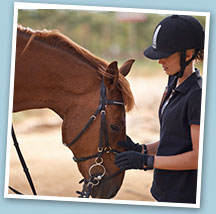
Helping a head-shy horse
Equine behaviourist Kelly Marks examines the reasons why some horses are head-shy, including medical problems and past bad experiences. What can caring owners do to ease this anxiety?
Head-shyness often means that handlers cannot get bridles on without a series of time-consuming manoeuvres – undoing straps, working up slowly from the neck to the face, trying to cope with a horse who consistently and insistently pulls away. These horses are typically worried about their ears being touched, and this ‘ear-shyness’ is likely to have been caused by bad management in the past.
Surely no educated person would think it acceptable to grab and twist a horse’s ear or nose to keep him still for shoeing or branding? Sadly, the practice is still encouraged in some cultures and even veterinary schools – and few horses ever get over the fear of being grabbed in such a way.
Underlying causes
Some horses can seem happy being handled around their faces, then suddenly jerk away as if they’ve been stung. This reaction is likely to be rooted in pain, and will require a vet and possibly a dentist to identify the problem. Various causes include dental problems, or irritation and infection specific to the ears: blackfly, aural plaque and sweet itch are all potential culprits. See vet Gil Riley’s excellent guide to ear issues for more on this.
Sedation for examination by an expert is generally advisable: behavioural problems concerning the face and ears are usually caused by past rough treatment and use of twitches (a restraining device used on the upper lip), so you don’t want to add to this with another experience your horse may find unpleasant.
Undoing the damage
The accepted wisdom on treating behavioural head-shyness is to put your hand up by a horse’s ear and keep it there until he relaxes – only then take your hand away. This follows the training principles of waiting until a required behaviour is performed. But the reality of, for example, a tall horse swinging his head in the air and accidentally smacking you in the face, means that this doesn’t always work very well in practice.
By far the easiest way to approach head-shyness is to ride another horse alongside your ‘patient’. That way, you are working from a level position rather than reaching up, and because your ear-shy horse is unlikely to have been abused by a human on another horse, he won’t necessarily connect your touch with previous suffering.
A soft touch
Gently rub your horse’s cheekbones, or somewhere else he can tolerate, with your hand – or a warm, damp flannel, which some horses find pleasant. Then quickly run your hand over his ears before returning to the place he doesn’t mind being touched. With repetition, he will start to register that he’s OK with his ears being touched, and isn’t suffering any fear response.
I have found this method to be very successful, though be warned – the ‘cure’ takes weeks rather than minutes, and it may be some time before he actively likes his ears being touched, rather than just tolerates it. Once he’s calm and happy, practise this exercise from the ground for a while. You should eventually be able to move on to using a bridle without having a battle. As ever, patience and understanding are key.


